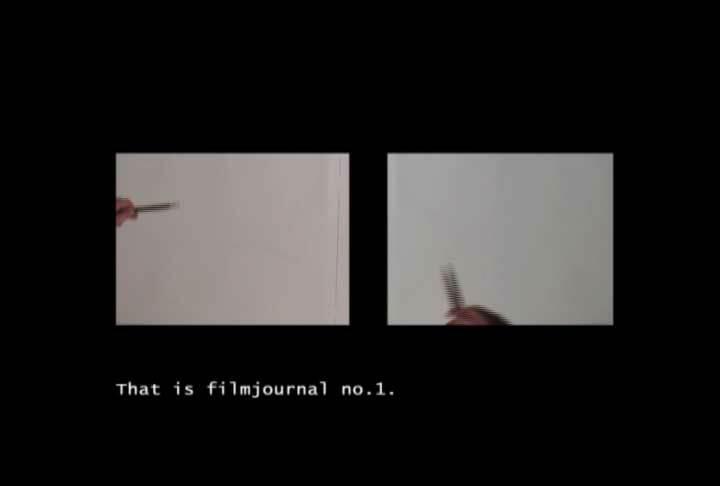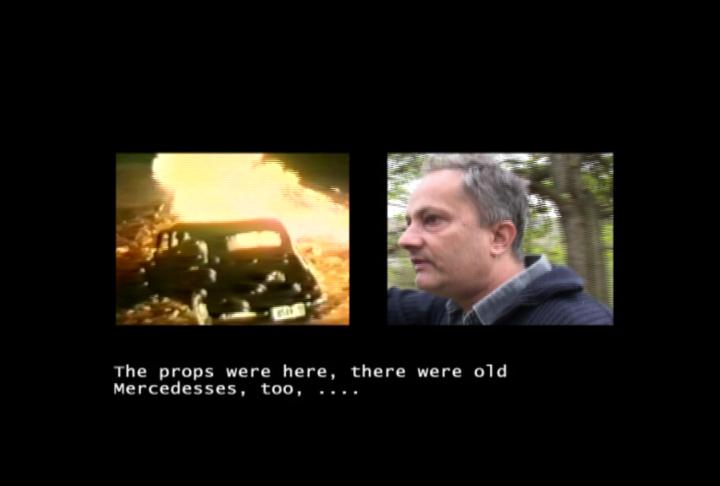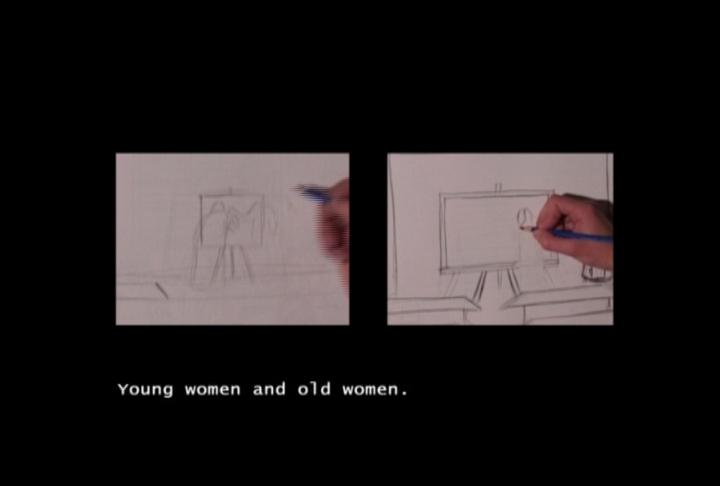Journal No. 1 - An Artist's Impression
Two years after the end of the Second World War, Film Journal No. 1 was released in Sarajevo, and four years after the collapse of the Communist bloc this newsreel, which has only survived on nitrate film, was lost in the confusion of the fighting in Yugoslavia. In Journal No. 1 An artists impression Hito Steyerl attempts to find out what was on this film document from Sarajevos Sutjeska studio. She listens to eyewitnesses, and according to her instructions artist Arman Kulasic made a number of drawings that resemble storyboards for some lost film. In the simultaneous projection of Journal No. 1 An artists impression the unattainability of a historical zero hour of the national identity takes concrete form: What appears to be a moment of great change in this look back (the newsreel reported on a literacy campaign, Muslim women confidently removed their headscarves, Communist Yugoslavia under Tito celebrated modernization through education in its early films) remains limited by subjective memory. Instead the artist, who was in fact intended to serve merely as a medium for the off-screen voices, is himself given a voice: He was affected by ethnic cleansing during the fighting. Whenever there are no documentary images available, Steyerl employs images from fiction films produced at Sutjeska (the anti-Fascist Valter brani Sarajevo [Walter Saves Sarajevo] and Do You Remember Dolly Bell? by Emir Kusturica), without however intending to make a complete reconstruction: Multiethnic Yugoslavia remains fragmentary, both in general history and the history of film, a country between the images.
(Bert Rebhandl)
dialoguelist / transcript 'Journal No. 1 - An Artist's Impression'
Title: In 1947 the first Bosnian newsreel was filmed.
Title: In 1993 Filmjournal No. 1 vanished during the Bosnian War.
Title: Journal No. 1 an artists impression
Let us reconstruct one scene from this film.
That is filmjournal No. 1
...but we dont have that particular journal.
Try to remember, and our graphic artist will draw.
The class for illiterates.
That was the alphabetisation of our elderly women and men
One of these film stories, which were very interesting
The hall looked like a regular classroom
There were several wooden benches
Two (people) sat on one bench
Two (people) sat in one row
In the front there wa a blackboard, it looked like your easel
The blackboard was mobile, kind of that like yours
And on the other side there was a handle
No, no, no, the blackboard stood on (a stand) and all round it had a kind of wooden frame
No, no. It was a regular blackboard. A regular blackboard.
Title: Halid Bunic, Projectionist and Restorer, Sarajevo filmmuseum
Title: Devleta Filipovic, Head of the filmarchive, Sarajevo filmmuseum
In the confusion of war 1992 the filmmaterial, shot on inflammable material, so called nitro film...
...unfortunately was located at the front-line. ThatŽs where the material was stored.
Title: Filmstudio Sutjeska
This was the film studio, montage, sound
Everything was there
Was it hit right at the beginning of the war?
It was burned.
And where was the front line?
The trenches were on this meadow.
The bunker that contained the inflammable films
It was a very small bunker up in that corner
Up in that corner, you canŽt see it because of the trees. It was in that corner over there.
Ok this was the bunker. Inside you would need a little light.
Title: Fahruddin Hadzanovic, gaffer, Sutjeska filmstudio
Do you see where they took them out? They opened it up there...
..and took them out.
During the height of the war, three monthly journals disappeared.
The Serbs took them away.
They took these films and carried them away.
They brought them in the house of the Djokic family.
That wasnŽt necessary at all. They took them and carted them away.
Unfortunately thatŽs where the material burned.
They took them away to Belgrade.
Because back then, they told us that it was carried into the Djokic house which was hit.
ThatŽs silly. Why should they leave it here?
The other films had already been evacuated before the war broke out. They were over there.
They were already shooting when we were evacuating these films.
Were you there? Yes.
The props were here, there were old Mercedesses, too...
..that were used in Walter defends Sarajevo
...but they were burnt.
Title: Valter brani Sarajevo. Sutjeska filmstudio 1972
There were 5 or 6 Mercedesses.
This was an army vehicle all props.
No, no, no, no not in this war, but in the other one. World War II.
We had wars earlier, too.
After World War II, there were a lot of illiterate women in Bosnia, mainly women.
Young women and old women.
Mainly women.
There were women from the villages, women from the city, there were Muslims who wore Samija and Kere.
They wore Samija on their heads.
A headscarf that was tied at the back or at the front how ever you like it!
Do you know what a Samija is?
Do you remember it?
Maybe you have seen something like it in old movies.
Title: Monthly Journal No. 1 1947
The Muslim anti-headscarf movement is spreading more and more.
For centuries, Muslim women were kept away from public life and society.
This course for illiterates,
I was sitting there because my grandma was taking care of me.
The old grandmas... they were learning the letter A like little children!
Veil and mask have realised her right for enlightenment and for the realisation of full equality.
...to work and life in general.
And when they started offering the course, grandma said:
...why should I be more stupid than other that I would sign my name with a cross.
I am not that stupid.
The Muslim women take off their veil and mask!
My grandma was proud. She said: I have learned to write, I have learned how!
I can now write and donŽt have to sign with little crosses anymore.
I can sign my name now!
There were unbelievably many. Believe me, I remember the face of illiterates.
And when you learned how to write, was it the teacher who stood at the blackboard?
ThatŽs right, she was... she wore a little shirt...
...and if someone didnŽt know, she took the hand of that person and said: - A.
And then she writes a lower case a but she does it really slowly, you know.
The chalk squeaks and suddenly you hear voices from the distance: aaaaa.
A-V-N-O-J (Anti-Fascist Council of National Liberation of Yugoslavia)
A, do you understand like an A
No, not like that, this is how itŽs done, start and then go upwards. Not as little as that.
An upper case A, thats it!
I think we should also add the lamp.
The lamp should hang right here?
It was hung. It was a very standard custom bulb.
Right about there is the lamp.
Lower than that. Lower, lower. Right there.
And now a little to the left...
...if you remember the film Dolly Bell...
Title: Do you remember Dolly Bell? Sutjeska Film 1981
Like a little hat, a small shade.
Not big, they werenŽt chandeliers it wasnŽt poverty.
A custom light, it was a very custom light bulb.
Title: Do you remember Dolly Bell? Sutjeska Film 1981
Development of autonomous programs, development of fraternalism and unity.
Strenghtening of self-administration in socialism...
Thats phenomenal. Yes, thatŽs how it was and TitoŽs image hung above the blackboard.
Above the blackboard. Yes. TitoŽs image was obligatory and it was already there.
There was always an image of Tito.
And for us Tito was a cult figure.
Titos image was essential, it was obligatory.
That was the most important thing, that it was obligatory.
Thats the way it goes.
And one canŽt find the material anymore?
But itŽs in Belgrade a hundred percent.
Maybe someone is holding on to it, privately.
This was the film archive.
These were the film racks.
Were!
Last call to the citizens of Sarajevo!
Parents or close relatives.
Take the bodies of your dead.
If she wants something interesting, she should go into the tin hut.
If the sun still shone now...shell splinters punched holes into her.
This all burnt down. This all came from the splinters and grenades.
Imagine if the sun shone right now!
Title: Valter brani Sarajevo Sutjeska filmstudio 1972
Parents or close relatives!
Take the bodies of your dead...
Hello, Mr. Orozovic?
Say you donŽt know where the Djokics house could be?
Three or four hundred meters behind Sutjeska film?
I think itŽs here.
Say the house was hit, the films were there and burnt, right?
They are lying.
If the films were brought over... when we got here, only the walls were left.
ItŽs only with them. Nowhere else. They took everything with them.
They probably know where it is but donŽt want to tell you.
ItŽs the easiest thing to say that they have been burnt.
Was this house hit?
Of course it was hit.
Do you know why... see, thatŽs where the front-line was...
Are you looking for houses that were burnt down? We are looking for films.
The assumption goes as follows: the material was brought into the Djokics home
And one of the BIH soldiers witnessed it being carried over there
Then the house was hit, thus the material burned.
Thats nonsense.
I dont know who could have said that.
...I canŽt prove to you whether they aimed at it on purpose but I assume so. And thats where the films were stored.
How was this film lost? No one knows, I donŽt know.
You didnt do well on this other leg, it were better it didnŽt exist.
I canŽt do it with this pencil, I need a liner.
I donŽt know why you donŽt understand me!
CanŽt you correct that? You have an eraser, correct it.
I mean if we are going to do it, then after memory.
I think itŽs important this is about alphabetisation!
One could decide whether to learn Cyrillic or Latin letters.
We alternated on one day we wrote Cyrillic the other Latin.
It wasnŽt important which writing.
I donŽt know did you learn both?
I was just starting school...
...when our class teacher said we would not write Latin letters anymore, only Cyrillic.
They had already taken over power.
Title: Arman Kulasic Graphic artist
So I went to school for two weeks, I was in sixth grade.
Then I stopped going to school.
The Serbian army had already taken over power in Prijedor.
And slowly, people of Croatian and Muslim faith started disappearing, I mean of Catholic and Muslim faith.
Right in the city centre they didnt talk about it a lot.
And I donŽt know whether the people knew about it or not.
But they probably knew.
Like in every other city. No one could believe that something like that could happen.
The mere existence of the five or six prison camps in the district of Prijedor, no one understood what was going on.
Our neighbor helped us.
He invited us to stay over for that night. One night.
And later on we found out that on that day there had been a cleansing that means all Croatians or Muslims were marched off to the camps.
We were the only Muslims in our street...
...that hadnŽt been taken to the prison camps yet.
And two or three days after that the crossing to Bosanski Novi was organised.
Do you remember that crossing? Were you inside a car?
I was inside the trunk of the car with my relative.
The two of us were inside the trunk and the rest was in the front.
My sister was down in the front, too, but down at the feet.
But I donŽt remember it well.
...on the premises of Sutjeskafilm. And in the back area there was a bunker for inflammable film...
Do you remember the old journals?
Films were lost, these old journals...
A mine fell during the war
And a grenade exploded. But I donŽt know anything about these films...
I heard that the house was burnt down.
It was horrible. To flee not from necessity.
So many people died, who are we supposed to accuse? One dosnŽt know, only God knows.
We crossed the bridge on foot, my father my mother my sister and I,
and reached this tampon zone thatŽs what it was called at that time.
Where the blue helmets of the Danish unit were stationed.
During that night, it was the first night in the early morning
At that place Dvor na Una, all children were released from school.
Adults and everyone gathered to throw stones at us.
And they did that? Yes.
They gathered early in the morning and started throwing stones at us.
We sat down, hunched down on the floor. And all around, the stones started crashing in.
There were these lunch packets, I remember them.
And we tried to use those packets to protect ourselves.
As a refugee to Croatia, I had no chance to go to school because we kept moving from city to city.
Title: Children, today you are off school!
Good afternoon! We are looking for the Djokics!
We are the Djokics!
You are the Djokics? Yes.
You see, we are shooting a film about Sutjeska film.
And we were told that during the war some inflammable films of Sutjeskafilm
Were transferred to the Djokics house.
The house was burned down. It is up here.
Is it that house over there? Yes.
And it was burned down? Yes it was burned down and all these films as well.
ItŽs that house. We have been looking for the Djokics for two days. They are everywhere.
Look at the baby! How old is it?
Six months.
Look how beautiful that baby is!
Did you see it Milan?
Are you the mother?
Just like the mother!
ThatŽs the house isnŽt it!
Can you remember when it was hit?
Long ago. In Ž94 or Ž95. I dont remember anymore.
I donŽt remember anymore. I would say so too. In 95 Srebrenica fell.
And thatŽs where the film reels were?
Yes and it all burned.
Can we go there and shoot it? This way.
The house used to have a roof, didnŽt it?
Yes, of course.
This is where the frontline was, wasnŽt it?
I donŽt know, the grenade came from below.
This was Serb territory.
There are several things here.
ThatŽs where the films are!
These are the film cans!
And so my sister went to America.
And we stayed in Rijeka a little longer and went to stay with my father who was living in Frankfurt.
I went to school and graduated from high school.
What about your sister?
My sister is still in America. Lives in New York.
Have you visited her? No I havenŽt because I have no chance to receive a visa from the Americans.
Because I am one of the most dangerous. One of the most dangerous groups.
I am a student. I have no work. My country is no good.
And on top of that I am a Muslim and I wanted to apply for the visa after 9/11.
I quickly was denied.
Title: Artists impression Arman Kulasic
Witnesses: Devleta Filipovic; Halid Bunic.
This leg is the only thing thats senseless, but the rest is great.
Could you erase it somehow? Maybe it can be done later. Erase it later.
Are you satisfied? I have good memory, donŽt I?
The End.
Journal No. 1 - An Artist's Impression
2007
Germany, Austria
21 min



